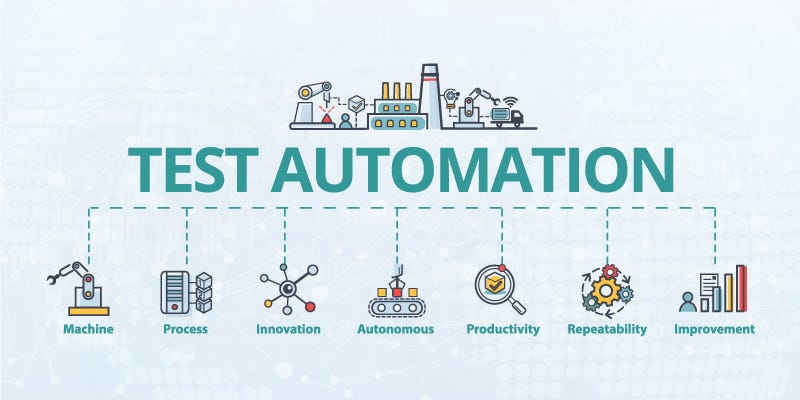Automation Testing Structures: Streamlining Complex Testing Circumstances
Automation Testing Structures: Streamlining Complex Testing Circumstances
Blog Article
Making Sure Success in Automation Checking: Key Metrics, Challenges, and Solutions Every QA Group Must Know
In the world of software high quality guarantee, the landscape of automation screening is ever-evolving, demanding a precise method to make sure seamless operations. The journey to mastering automation screening is led with nuances that require a keen eye for surveillance, evaluation, and continual improvement. As the industry moves forward, the pursuit for optimum efficiency in automation testing remains a continuous quest, prompting QA groups to outfit themselves with the understanding and strategies essential for triumph.
Relevance of Key Metrics
Understanding the significance of vital metrics is essential for evaluating the performance and effectiveness of automation screening procedures. Secret metrics work as measurable procedures that supply beneficial understandings right into numerous aspects of the screening process, such as test insurance coverage, examination execution time, problem thickness, and examination situation efficiency. By examining these metrics, QA teams can determine bottlenecks, inadequacies, and areas for improvement within their automation testing structure.
One important facet of crucial metrics is their capacity to track progression and keep track of the overall health of the screening process (automation testing). They enable stakeholders to make educated choices based on data-driven insights, which can lead to much more efficient testing approaches and far better source appropriation. Additionally, essential metrics can help teams established practical objectives, measure the success of automation initiatives, and show the ROI of automation testing efforts

Usual Difficulties Encountered
Difficulties frequently run into in automation screening processes can significantly influence the overall performance and performance of QA groups. Automation screening may not cover all elements of testing, such as use and user experience testing, which still call for hand-operated treatment. Conquering these challenges requires appropriate planning, strategic examination situation selection, robust maintenance processes, appropriate resources, and a clear understanding of the constraints of automation screening.
Effective Solutions for Difficulties
To deal with the challenges come across in automation testing, applying reliable remedies is vital for improving the performance and productivity of QA groups. One key option is to spend in durable training programs for QA teams to guarantee they have the needed skills to successfully make use of automation tools. Training can connect expertise voids, enhance understanding of automation structures, and enhance scripting abilities, inevitably leading to much more efficient examination development and execution.
Another important service is to develop clear interaction channels within the QA group and with other stakeholders, such as programmers and project supervisors. Efficient interaction aids in lining up assumptions, sharing progression updates, and promptly resolving problems or roadblocks that might emerge throughout the automation screening procedure.

Monitoring and Evaluation Methods
Executing effective surveillance and analysis methods is important for ensuring the success and efficiency of automation testing processes. In addition, analyzing test outcomes and metrics gives beneficial insights right into the high quality of the software program being checked and the efficiency of the testing strategy.
One key technique in surveillance and evaluation is making use of control panels that settle pertinent metrics and KPIs in an aesthetically obtainable layout. These control panels her latest blog provide a detailed introduction of examination execution status, examination coverage, flaw patterns, and various other important information. Regularly examining and evaluating these control panels can assist QA teams make notified decisions, prioritize tasks, and enhance screening initiatives.
Additionally, implementing automated informs and notices based upon predefined limits can enhance proactive surveillance and timely intervention. By establishing informs for performance inconsistencies or examination failures, teams can resolve concerns without delay and prevent them from intensifying. Overall, monitoring and analysis methods play a crucial duty in guaranteeing the performance and success of automation screening initiatives.
Continual Improvement Strategies
Enhancing the effectiveness of automation screening processes requires the regular refinement of methodologies and strategies. One crucial strategy to enhancing view it automation screening processes is to perform regular testimonials and retrospectives.

Final Thought
In final thought, it is essential for QA groups to comprehend the vital metrics, challenges, and solutions in automation testing to make sure success. By thoroughly monitoring and evaluating information, executing effective options to usual challenges, and constantly improving methods, QA teams can optimize their screening procedures and provide high-grade software. Abiding by these techniques will ultimately result in much more effective and reliable automation testing methods.
By analyzing these metrics, QA teams can recognize bottlenecks, inefficiencies, and areas for renovation within their automation screening framework.
Furthermore, crucial metrics can assist groups established sensible objectives, determine the success of automation campaigns, and demonstrate the ROI of automation screening initiatives.
Difficulties commonly come across in automation screening procedures can substantially influence the overall effectiveness and effectiveness of QA groups. Automation screening may not cover all aspects of testing, such as use and customer experience testing, which still call for manual treatment.In conclusion, it is vital for QA teams to comprehend the key metrics, obstacles, and solutions in automation screening to make sure success.
Report this page